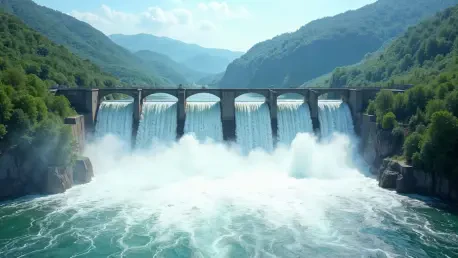Across the sweeping landscapes of Arunachal Pradesh, a quiet but powerful transformation is underway. With the state’s abundant river resources and unique geographical advantages, it is fast becoming a cornerstone in India’s ambitious push toward renewable energy. The region is funneling substantial investments into hydropower projects not just to harness energy for local demands but to contribute significantly to the national grid, thus propelling India further into the green energy era. This move comes as part of India’s broader commitment to reducing fossil fuel dependency in line with international agreements on climate change.
Overview of the Green Energy Landscape
India has seen remarkable progress in its green energy initiatives, with renewable energy constituting a pivotal part of its energy strategy. The country’s significant strides are reflected in increased capacity and diversified technological advancements, driven by both domestic and global players keen on exploring sustainable energy sources. The Ministry of New and Renewable Energy’s policies reinforce this momentum by offering incentives and clear guidelines to boost the renewable sector, making it a national priority.
Technological innovations have played a pivotal role, allowing for the integration of wind, solar, and hydroelectric resources into one cohesive framework. Major corporations involved in energy production are increasingly investing in smarter, more efficient technologies, paving the way for increased production and reduced costs. Consequently, the renewable energy sector is not just seen as a pathway to sustainable development but also as an economic opportunity, contributing significantly to India’s GDP.
Arunachal Pradesh’s Strategic Role
Key Trends and Developments
In the heart of Arunachal Pradesh, the state government, spearheaded by Chief Minister Pema Khandu, has embarked on an ambitious journey to tap its river systems for hydroelectric power. Focusing on the Siang, Subansiri, and Dibang river basins, the state plans to deploy run-of-the-river hydropower models. This approach leverages the natural flow and gradient of rivers to generate electricity, thereby minimizing environmental disruption compared to traditional dam systems.
Moreover, the influx of investments, surpassing ₹1 lakh crore, underlines the state’s commitment to these sustainable projects. Numerous initiatives are underway with several major players in the consumption sector partnering with local stakeholders, assuring the effectiveness and execution of these projects. This strategic collaboration is integral in ensuring both financial viability and community involvement in the region.
Projections and Economic Impact
The transformative potential of these projects is evident in ambitious energy generation targets. Once operational, they are expected to contribute more than 13,000 megawatts of power, significantly fueling India’s green energy capacity. These initiatives hold promise for substantial economic gains, notably through job creation. Over the course of the projects, thousands of direct and indirect employment opportunities have emerged, spanning construction, logistics, and long-term power management.
Economic growth is further bolstered by new infrastructure developments accompanying these projects. The state is witnessing a surge in road and bridge construction as well as digital connectivity, which together revitalize previously remote communities. These infrastructural improvements are projected to have positive spillover effects on local industries such as tourism and agriculture, driving the broader economic landscape of Arunachal Pradesh toward prosperity.
Challenges and Complexities
Despite promising strides, Arunachal Pradesh faces inherent challenges in harnessing its hydropower potential. The state’s mountainous terrain and unpredictable climatic conditions, including frequent heavy rainfall, pose logistical challenges for energy projects. To navigate these obstacles, an agile monitoring team has been established to oversee project progress and mitigate risks, ensuring timelines and targets are met.
Equally important is addressing environmental and ecological concerns. With interventions in delicate ecosystems, each project undergoes stringent environmental assessments to minimize negative impacts. The state has prioritized maintaining the region’s biodiversity while simultaneously pursuing energy goals. Such balanced approaches are crucial in sustaining community support and preserving Arunachal Pradesh’s rich natural heritage.
Regulatory and Compliance Framework
The regulatory framework governing Arunachal Pradesh’s energy projects is pivotal in shaping their execution. Numerous laws and standards regulate the planning, implementation, and operation of these ventures, ensuring they align with both national and international environmental protocols. Recent amendments in policies emphasize sustainability, further influencing project planning and long-term viability.
These regulatory shifts necessitate adept navigation to avoid potential hurdles in development. Comprehensive understanding and continuous updates on these frameworks are essential for stakeholders to adapt and comply. Ensuring compliance not only safeguards environmental standards but also promotes security and efficiency in energy operations, fortifying confidence among investors and local communities alike.
Future Prospects and Innovations
As Arunachal Pradesh continues its renewable energy journey, several trends emerge that may redefine its trajectory. Innovations in energy storage and grid management technologies could become game-changers, enhancing efficiency and reliability. Such advances allow for better integration of renewable sources, optimizing energy use and minimizing wastage.
Consumer interests are also evolving, with a growing demand for cleaner, more affordable energy solutions. This shift compels energy producers to adapt swiftly, tailoring services to meet the new expectations of market participants. Future growth areas may also emerge in technology swaps, where renewable energy combines with other sectors like agriculture, to create more sustainable ecosystems.
Conclusion and Recommendations
As 2025 propels Arunachal Pradesh further in its green energy efforts, several key insights emerge from this exploration. The state’s ventures in hydropower not only position it at the forefront of India’s renewable strategy but also herald a promising era of economic regeneration and environmental stewardship. The ongoing journey offers fertile ground for investments, particularly in infrastructural enhancements and technological innovations.
Looking forward, maintaining momentum and ensuring that regulatory frameworks foster ease of execution remain central to success. With strategic planning and responsible management, Arunachal Pradesh is well-poised to solidify its role as a pivotal energy producer. This narrative of progress aligns with both regional ambitions and national green energy goals, setting a benchmark for other regions to emulate in pioneering sustainable futures.









